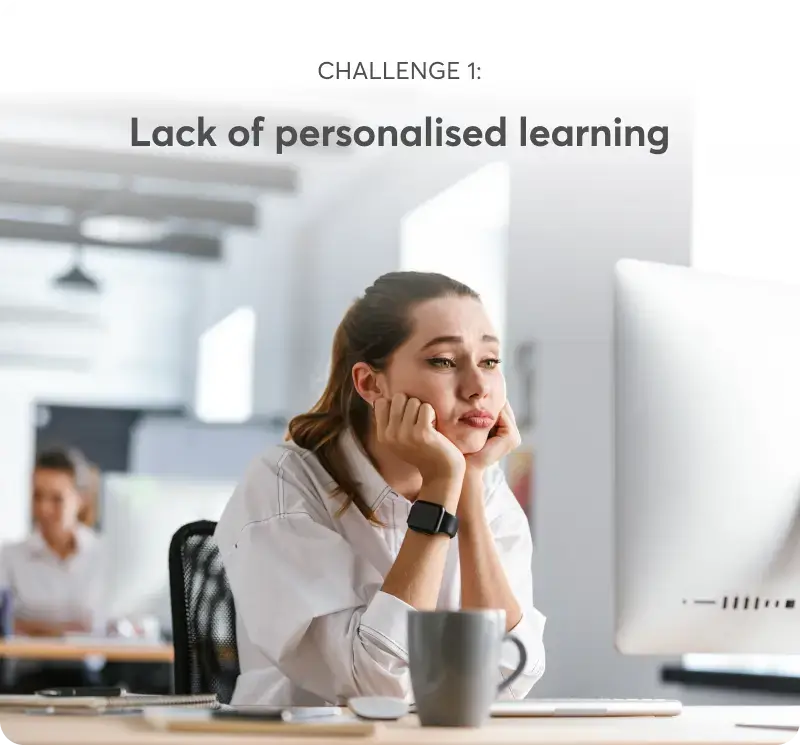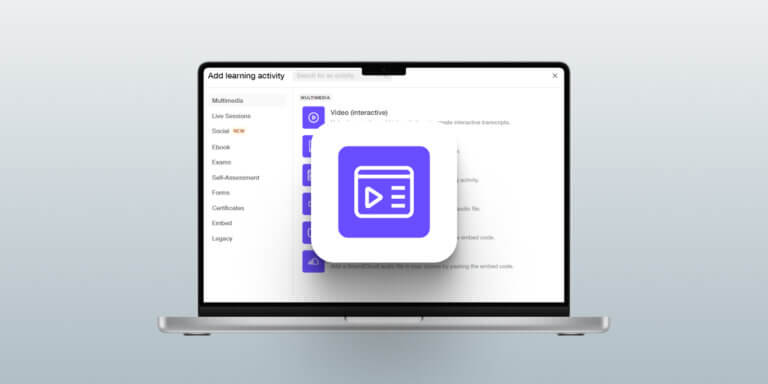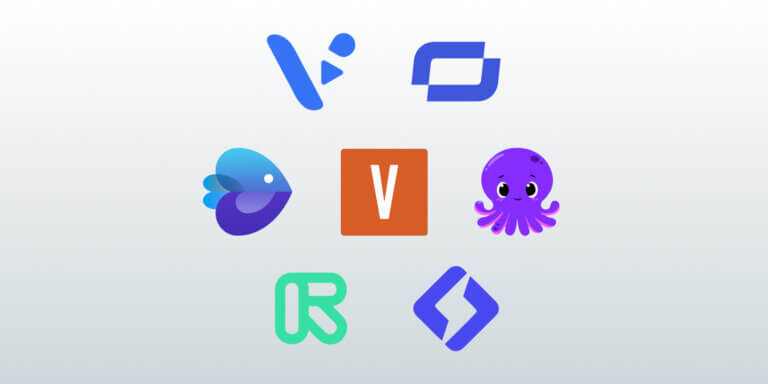Table of Contents
Maya just stepped into her new role as an L&D professional at a fast-growing SaaS company. They call her “the Ted Lasso of learning”. She is full of optimism, navigating stakeholder meetings and outdated slide decks with a coach’s determination. Her mission? To turn disconnected efforts into a unified, results-driven training program.
And, she’s got the data to back her case.
Whether you’re part of an established organization or one of the corporate training startups on the rise, one thing’s clear: L&D is no longer an optional expense but a strategic driver.
So, Maya knows that building effective AI corporate training programs that deliver real value is harder than it looks. What’s getting in the way? Let’s look at the key challenges holding education and workforce development programs back in 2025, and what leaders like Maya can do about it.
Key challenges in corporate training
Even with learning management systems in place, many corporate training programs still miss the mark in 2025. Below are the three main challenges standing in the way of meaningful impact.
Challenge 1: Lack of personalized learning

Let me share a personal reflection. Back in my university days, personalized learning experiences were pitched as the Holy Grail for education—the thing every educator should aim for. But in practice? There are many reasons why most personalization attempts at learning and training fall short. In my opinion, the same is true in corporate learning.
Challenge 2: Monotonous and boring course content

Static course designs, text-heavy, typical of traditional training methods, negatively affect learners’ attention span, which drops fast in talent development. Recent research findings confirm the previous argument, showing that interactive content is more engaging in comparison to static text-based learning materials [3].
Challenge 3: Inefficient learning administration

Another research shows that 30% of L&D employees’ time is lost to manual admin tasks [4]. As Learning & Development expert Sarah Cannistra highlights, “About 90% of my time was spent sourcing and vetting content, and the rest on administrative matters to make sure the right people were in the right training at the right time.” [5].
AI internal training programs have the potential to drive employee skill enhancement or build leadership and professional development pipelines, but only if paired with thoughtful design and execution.
Next, let’s look at how AI is reshaping corporate learning platforms—and what that means for L&D leaders like Maya and you.
The rise of AI in corporate training with AI LMS
93% of Fortune 500 CHROs now say their companies use AI-powered tools to improve business functions, with employee training at the center [6]. According to McKinsey, 78% of companies are using AI in at least one area, and the adoption of AI-powered learning solutions like generative AI doubled in the six months leading into 2024 [7, 8].
A LearnWorlds usage report shows that AI is now part of the course creation experience for more than 30% of users, and that number is growing. For many organizations, this is an essential shift.
L&D teams are adapting fast as well. So must the enterprise training platforms and learning management systems. From time to time, I read various posts on LinkedIn about how training platforms will survive in the AI-dominated learning era. The truth is that the AI momentum forced the LMSs to evolve into AI-driven LMS solutions that do more than host content and manage learners.
Powered by machine learning and large language models, these LMSs are helping you:
This hands-on support directly strengthens employee competencies’ enhancement efforts, eliminating the manual friction that once slowed program rollouts.
Proven AI solutions transforming corporate learning
L&D teams know that faster content, adaptive modules, or chatbot tutors don’t always lead to better outcomes. AI provides better results only when directed with clear intention. Here’s how today’s AI-assisted tools are being applied effectively in talent development.
For example, the new “Learning Mode” that Claude for Education is introducing brings students’ analytical thinking processes into the foreground and helps them better understand by employing the approach of Socratic questioning: “How would you approach this problem?” or “What evidence supports your conclusion?” [9].
LearnWorlds is moving beyond basic testing knowledge recall with AI-enhanced learning solutions that inquire and examine learners’ thinking. Our in-progress new AI-enhanced assessment features allow you to clarify misconceptions, uncover reasoning patterns, and understand your learners’ mental models to help them further refine the next learning steps.
This is essential because when learners feel understood and not just scored, they stay engaged.
AI is reshaping how we think about scale, relevance, and impact. But these tools only succeed when they work with L&D experts, not around them.
AI’s ideal uses for trainers in corporate environments
Across industries, L&D professionals are shifting from content producers and admin coordinators to what they’ve always wanted to be: strategists, facilitators, and learner advocates. AI talent development is finally freeing them to focus on the work that moves the needle.
Here’s where AI is adding the most value for trainers today and what that unlocks.
Freeing time from admin chaos
Before AI, Maya’s calendar was clogged with follow-ups, reminders, and training tracking course completions manually. Now? Her LMS handles that in the background. Tools can auto-enroll employees into programs based on job roles, trigger timely nudges, and log completions, without her lifting a finger.
Zapier’s L&D team managed to save 1,000 hours per year by automating time-consuming repetitive tasks and reinvesting that time into program quality [10]. That is the lesson that AI teaches us here. This is how to approach workflows and transform them to our advantage.
Accelerating content creation without sacrificing quality
Maya no longer starts from scratch. With the help of AI, she drafts course outlines, quizzes, and even videos in minutes, then adds the human layer that brings them to life. Additionally, she chooses to repurpose course content with AI, which is another way to create learning materials quickly.
Bayer, for example, has developed a large language model to summarise the company’s procedural documents and produce multi-modal compliance learning materials. These materials with the help of other AI tools, can be transformed into video or animations [11].
As Dr. Ashwin Mehta, Global Learning Technology and Innovation Director, explains: “Content generation is where you take text and make another type of content out of it, whereas content enrichment is taking content and using it to build, say, a game world. The ambition is different.” [11].
Delivering instant feedback and answering questions without burnout
Every learner wants real-time feedback, but this is not always feasible in corporate training opportunities. AI can assist in this case. For example, LearnWorlds is offering AI-powered tools that can help L&D trainers provide instant feedback and automatically score employees’ responses, considering the instructors’ directions. Feedback is most powerful when it’s timely, and AI makes that sustainable.
Making impact measurable by analyzing data
AI analytics track learner behaviors like engagement, completion rates, and assessment scores and correlate them with key business metrics such as sales performance, productivity, or error reduction. They also use historical and real-time data to forecast skill gaps before they affect performance, enabling proactive approaches to design learning strategies.
Segmentation by role, team, and performance trends helps L&D target the right people with the right programs, maximizing impact and optimizing resource allocation.
What’s next for AI in corporate training?
What’s next for AI in corporate training? That’s a tough question to answer, but here are some ideas, which you can take or leave.
The ethical side of things
AI is becoming embedded in corporate training opportunities more and more, which means the biggest challenge ahead for me isn’t technical but ethical. Who decides what AI teaches, and whose knowledge does it reflect?
If AI tools generate biased or incomplete content, the damage goes deeper than one bad module, as it can reinforce inequality at scale. While companies rush to automate, they must also build safeguards. That includes transparency about AI-generated content, curated datasets, and clear labeling when learners interact with a bot versus a human. Responsible design is no longer a legal checkbox, it has to become a trust builder.
The need to reskill employees
At the same time, the pressure to reskill employees is growing. With AI transforming job roles across industries, L&D can’t afford to wait for skills gaps to show up in performance reviews. What’s needed is a proactive, AI-driven reskilling strategy – one that analyzes market shifts, performance data, and internal capabilities to predict emerging skill needs before they become urgent.
That means delivering learning in real-time, in smaller, more targeted formats, like, for example, a quick training prompt after a missed KPI, a short video when a tool is underused, or a scenario module triggered by behavior patterns.
Still, all of this hinges on one underrated competence: knowing how to ask the AI better questions. As AI becomes your training assistant, prompt engineering becomes your secret weapon. Up next, let’s discuss what that means and why every L&D team today needs it.
💁🏻♀️Learn how to use AI training for employees to get your business ahead of the competition.
Why prompt engineering is a must-have skill for training managers
Some experts argue that as AI gets smarter, prompt engineering won’t matter – that models will “just know” what we mean. But that’s a risky oversimplification. As we shift toward AI agents that handle complex tasks across multiple tools, prompt engineering becomes more critical.
Here’s why prompt engineering matters:
💡The good news? Prompt engineering is a learnable skill, and LearnWorlds offers a 9-step framework to help you master it.
Top benefits of AI LMS in corporate training for businesses
Let’s roll back to the story of our L&D expert, Maya. Back in Q1, Maya was racing to catch up as a new member, juggling onboarding, compliance, leadership training, and department-level requests. But once her team rolled out an AI-powered learning solution, like LearnWorlds, the difference was immediate.
Here’s what Maya and other L&D leaders navigating today’s AI corporate training landscape are gaining by using intelligent platforms built for the future:
Ready to offer AI corporate training?
In this article, we’ve explored how AI is reshaping corporate training from automating admin and making content creation quicker to personalizing learning paths and predicting future skill gaps.
But it’s not just about speed or automation. It’s about intentional design. AI gives us powerful capabilities, still it doesn’t replace the strategic thinking, empathy, and creativity that define great training. The challenge now is making sure we’re not just using AI to do more but to do better.
Prompt engineering, ethical safeguards, and skill-based data interpretation are fast becoming core competencies for modern L&D. The question isn’t if AI fits into your training strategy—it’s how you’ll lead its integration thoughtfully and effectively.
So, why wait?
If you’re ready to turn your LMS into an intelligent, scalable, and intuitive growth engine, LearnWorlds is your partner in transformation. Get your free trial today.
Sources:
[1] https://blog.tbrc.info/2025/02/corporate-training-market-size/
[2] https://learning.linkedin.com/resources/workplace-learning-report
[3] https://www.frontiersin.org/journals/nutrition/articles/10.3389/fnut.2022.811103/full
[4] https://www.offbeat.works/post/a-down-to-earth-talk-about-learning-development-automation
[5] https://www.rippling.com/blog/building-successful-learning-development-programs-webinar
[6] https://www.gallup.com/workplace/651203/workplace-answering-big-questions.aspx
[7] https://www.mckinsey.com/capabilities/quantumblack/our-insights/the-state-of-ai
[9] https://www.anthropic.com/news/introducing-claude-for-education
[10] https://zapier.com/blog/automate-learning-development-workshops/
[11] https://donaldhtaylor.co.uk/research_base/focus02-talk-to-action/
Panagiota is an Instructional Technologies Specialist at LearnWorlds, holding a Ph.D. in Technology Enhanced Learning. Her research focuses on the integration of educational technologies into learning and instruction. In her spare time, she enjoys gardening and staying connected with nature.
FAQ
Everything you have ever wondered, but were too afraid to ask...





